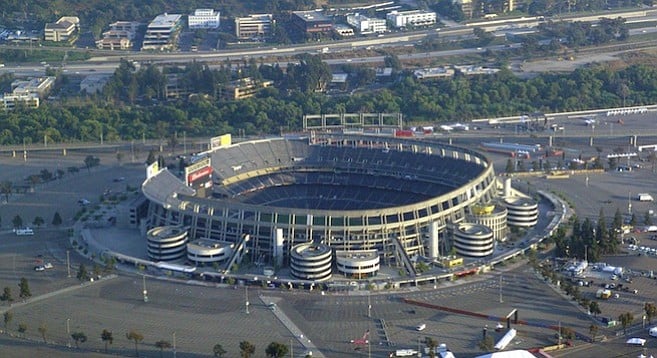 Facebook
Facebook
 X
X
 Instagram
Instagram
 TikTok
TikTok
 Youtube
Youtube

The Los Angeles Times is reporting this evening (March 9) that Anschutz Entertainment Group (AEG), owned by multi-billionaire Philip Anschutz, is pulling out of its plans to build a football stadium in downtown Los Angeles.
"We are no longer in discussion with the NFL or any NFL team," reads a company statement. Just a week ago, it appeared that AEG was going all-out to block the plans of multi-billionaire Stan Kroenke, owner of the St. Louis Rams, who has all the entitlements to build a stadium in Inglewood.
The move may — may — open doors for the Chargers to try to be a second team occupying the Inglewood site, along with the Rams. Kroenke would bring in much more money if he had a second team to bring in ticket, advertising, naming rights, parking, TV, and other revenue at the planned stadium. However, money could be the hangup.
Forbes estimates the Spanos family is worth $1.25 billion, and $1 billion of that represents ownership of the Chargers. Kroenke would probably demand more than $250 million, and the family would be reluctant to put the rest of its money in a stadium. However, the Chargers could figure that the team's value would rise, perhaps by a billion dollars, and it could afford to borrow to get the second slot at Kroenke's stadium.
The Oakland Raiders would like to get into L.A., too, but the owning Davis family doesn't even have one billion in assets, according to Forbes. Oakland might wind up in St. Louis, playing for almost nothing. That city knows it will probably lose the Rams and doesn't want to be stood up a second time. St. Louis built the current stadium, which is only 20 years old. The Los Angeles Rams moved there in the mid-1990s. Earlier, the team that is now the Arizona Cardinals left St. Louis high and dry.
Actually, the Chargers do not have the funds to contribute any significant amount to a San Diego stadium. The team claims that 30 percent of its fan base comes from Orange and L.A. Counties. That's probably hyperbole, but if it is 20 percent, it is a big bite out of revenue and may be enough to kill the idea of a new stadium.
Attendance at Qualcomm has been mediocre in recent years. The most likely result is the Chargers continuing to play at Qualcomm and the Raiders continuing to play in Oakland. But AEG's dropping out does present the Chargers with a long shot in Inglewood.


The Los Angeles Times is reporting this evening (March 9) that Anschutz Entertainment Group (AEG), owned by multi-billionaire Philip Anschutz, is pulling out of its plans to build a football stadium in downtown Los Angeles.
"We are no longer in discussion with the NFL or any NFL team," reads a company statement. Just a week ago, it appeared that AEG was going all-out to block the plans of multi-billionaire Stan Kroenke, owner of the St. Louis Rams, who has all the entitlements to build a stadium in Inglewood.
The move may — may — open doors for the Chargers to try to be a second team occupying the Inglewood site, along with the Rams. Kroenke would bring in much more money if he had a second team to bring in ticket, advertising, naming rights, parking, TV, and other revenue at the planned stadium. However, money could be the hangup.
Forbes estimates the Spanos family is worth $1.25 billion, and $1 billion of that represents ownership of the Chargers. Kroenke would probably demand more than $250 million, and the family would be reluctant to put the rest of its money in a stadium. However, the Chargers could figure that the team's value would rise, perhaps by a billion dollars, and it could afford to borrow to get the second slot at Kroenke's stadium.
The Oakland Raiders would like to get into L.A., too, but the owning Davis family doesn't even have one billion in assets, according to Forbes. Oakland might wind up in St. Louis, playing for almost nothing. That city knows it will probably lose the Rams and doesn't want to be stood up a second time. St. Louis built the current stadium, which is only 20 years old. The Los Angeles Rams moved there in the mid-1990s. Earlier, the team that is now the Arizona Cardinals left St. Louis high and dry.
Actually, the Chargers do not have the funds to contribute any significant amount to a San Diego stadium. The team claims that 30 percent of its fan base comes from Orange and L.A. Counties. That's probably hyperbole, but if it is 20 percent, it is a big bite out of revenue and may be enough to kill the idea of a new stadium.
Attendance at Qualcomm has been mediocre in recent years. The most likely result is the Chargers continuing to play at Qualcomm and the Raiders continuing to play in Oakland. But AEG's dropping out does present the Chargers with a long shot in Inglewood.
Comments